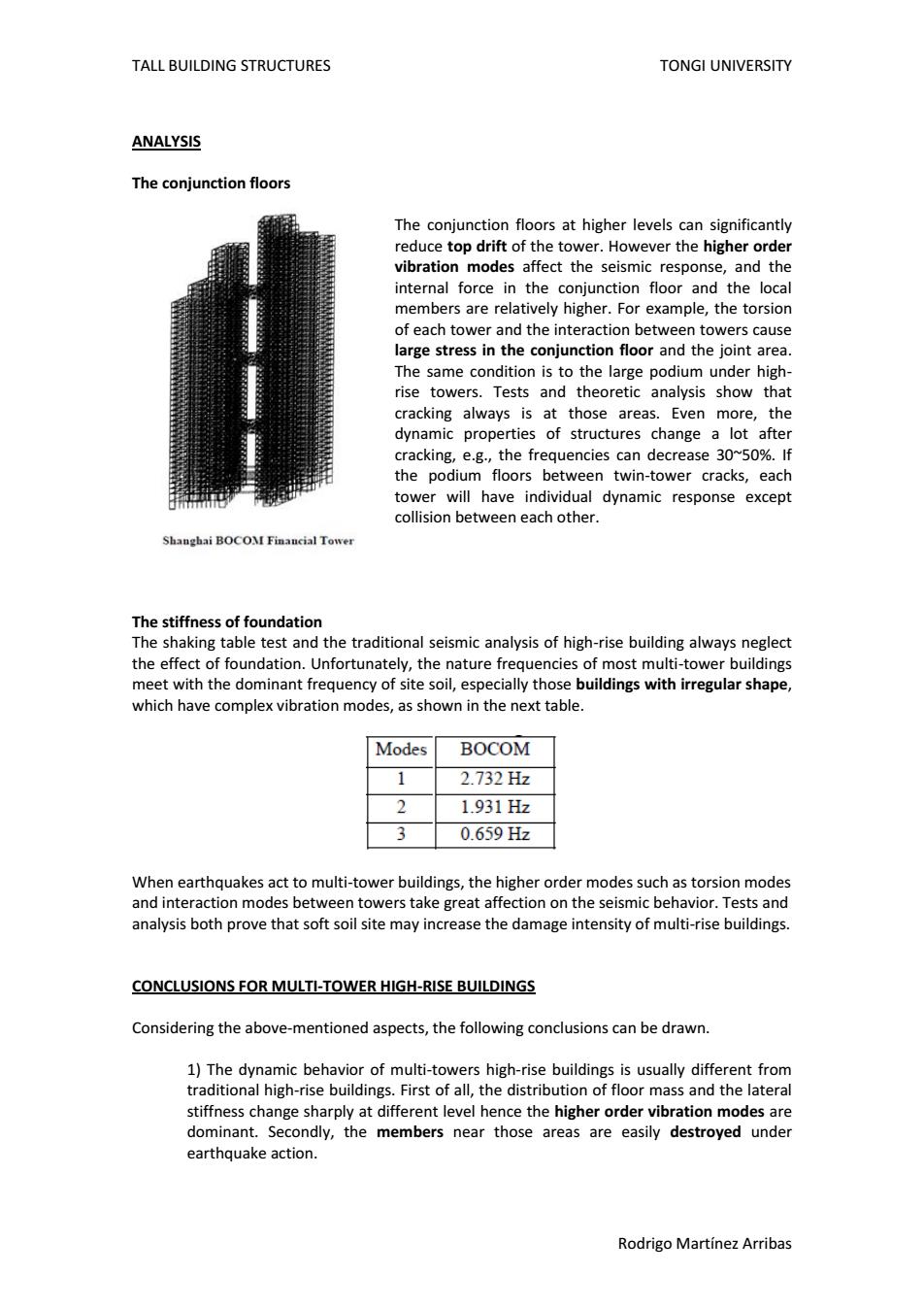正在加载图片...

TALL BUILDING STRUCTURES TONGI UNIVERSITY ANALYSIS The conjunction floors The coniunction floors at higher levels can significantly reduce ton drift of the tower However the higher order vibration modes affect the seismic response,and the internal force in the conjunction floor and the local members are relatively higher.For example,the torsion of each and the interaction betw en towers caus rge stress ir on or an e nt an and th cracking always is at those areas Even more the dynamic properties of structures change a lot after cracking,e.g.,the frequencies can decrease 30~50%.If the podium floors between twin-tower cracks,each tower will have individual dynamic response except collision between each other. Shanghai BOCOM Financial Tower The stiffness of foundation The shaking table test and the traditional seismic analysis of high-rise building always neglect the effect of foundation.Unfortunately,the nature frequencies of most multi-tower buildings nt f equency of site soll,es buildings with irregular shape, Modes BOCOM 1 2.732Hz 2 1.931H 3 0.659Hz uakes ac order analysis both pr ve that soft soil site may increase the damage intensity of multi-rise building CONCLUSIONS FOR MULTI-TOWER HIGH-RISE BUILDINGS Considering the above-mentioned aspects,the following conclusions can be drawn. 1)The dyn stiffness change sharply at different level hence the higher order vibration modes are dominant.Secondly,the members near those areas are easily destroyed under earthquake action. Rodrigo Martinez ArribasTALL BUILDING STRUCTURES TONGI UNIVERSITY Rodrigo Martínez Arribas ANALYSIS The conjunction floors The conjunction floors at higher levels can significantly reduce top drift of the tower. However the higher order vibration modes affect the seismic response, and the internal force in the conjunction floor and the local members are relatively higher. For example, the torsion of each tower and the interaction between towers cause large stress in the conjunction floor and the joint area. The same condition is to the large podium under highrise towers. Tests and theoretic analysis show that cracking always is at those areas. Even more, the dynamic properties of structures change a lot after cracking, e.g., the frequencies can decrease 30~50%. If the podium floors between twin-tower cracks, each tower will have individual dynamic response except collision between each other. The stiffness of foundation The shaking table test and the traditional seismic analysis of high-rise building always neglect the effect of foundation. Unfortunately, the nature frequencies of most multi-tower buildings meet with the dominant frequency of site soil, especially those buildings with irregular shape, which have complex vibration modes, as shown in the next table. When earthquakes act to multi-tower buildings, the higher order modes such as torsion modes and interaction modes between towers take great affection on the seismic behavior. Tests and analysis both prove that soft soil site may increase the damage intensity of multi-rise buildings. CONCLUSIONS FOR MULTI-TOWER HIGH-RISE BUILDINGS Considering the above-mentioned aspects, the following conclusions can be drawn. 1) The dynamic behavior of multi-towers high-rise buildings is usually different from traditional high-rise buildings. First of all, the distribution of floor mass and the lateral stiffness change sharply at different level hence the higher order vibration modes are dominant. Secondly, the members near those areas are easily destroyed under earthquake action